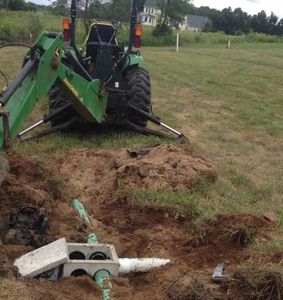Services
Septic Tank Pumping

Having your septic tank pumped is the most important maintenance you can do to protect your septic system. Having your tank pumped is recommended every 2-5 years depending on how many people live in your house, how much water is used in the house, how big your septic tank is, and how responsible the house is about what is draining down the house sewer to the tank.
If your septic tank is not pumped under the criteria mentioned above, solid waste can build up in the tank and pass on to the leaching area causing a premature failure of the septic system, or the solids can build up around the inlet pipe from the house causing a backup to the house.
When we pump your tank, we locate and dig the covers, pump the tank, give the structure a visual inspection, and make any recommendations to help prevent septic problems in the future.
Septic System Repairs/Installations

Unfortunately, all septic systems do eventually need repairing. The Riebold’s have the knowledge and years of experience to repair every problem your septic system may be giving you. At Riebold Sanitation, we will dissect the problem and try to find a possible cure before replacing the system completely. The problem could be a separated pipe, tree roots entering the pipe, crushed lines, improper pitch, etc. We take such great pride in our work that if we can fix your problem without disturbing the majority of your yard and preventing a major hit to your wallet, we feel a better sense of accomplishment than if we installed a new septic system.
Of course, if the inevitable happens and a complete replacement is needed, we are experienced at every type of septic system that can be used on your property. We can make the proper recommendation of which type would be most suitable for your needs.
We at Riebold Sanitation, LLC always work closely with the local health department, taking all proper permits to ensure the customer that their new septic system is installed as the manufacturer intended and properly documented with the health department office. In fact, we are trusted and respected by numerous health department inspectors, that they have hired us to work at their houses.
At Riebold Sanitation, LLC we are experts in:
- Repairing and Replacing crushed pipes
- Unclogging blocked pipes
- Septic tank installation and replacement
- Baffle replacement
- Pump systems
- Engineered systems
- Replace distribution boxes
- Concrete systems
- Curtain and Footing drains/ Watershed
- Leaching trenches
- Infiltrater Systems
- Soil testing and test hole digging
Real Estate Inspections

Purchasing a new house can be the biggest investment you can make. Ensuring that the septic system is in working condition before making the ultimate decision is where we come in. We educate the buyer about the system so they know what proper care practices can be instilled, and warn them if any existing problems that may be occurring.
An inspection first and foremost starts with and interior inspection of the house. We look for backwash from water treatment systems, garbage disposals, and hot tubs that could be draining into the septic system. We look for these because they can have and adverse affect on how much damage they may have caused or can cause in the future. A water treatment system is not permitted to discharge into the septic system. On-site disposal of water treatment system wastewater shall have a dedicated area separate from the septic system. Houses with garbage disposals and hot tubs draining into septic systems are required to have a septic tank that is 250 gallons bigger than the size tank required for the amount of bedrooms in the house.
Next, we locate and open the front and rear covers of the septic tank. If the covers are more than 1 foot deep, the Connecticut Public Health Code requires that the tank is retrofitted with risers. This will bring the access to the tank closer to the surface. We inspect the water level in the tank, check for stress cracks in the concrete, and the general condition of the inlet and outlet baffles.
We will run some water from the house to verify the pitch in the pipes to the tank is correct and that there are no obstructions.
After these steps are completed, we will pump the tank. We can see how responsible the existing homeowner was with maintenance of the septic system while pumping by how much solids have accumulated, what makes up the contents of the solids (grease, anti-bacterial wipes, feminine products, etc) and if the tank should have been pumped sooner. Pumping will also determine the size of the tank.
A visual inspection of the leaching area will be conducted to get an idea of how well they are working. We look for saturated areas on the ground, greener grass, settling of the ground, and then probe the area to check for further ground saturation. Recommendations will be made for protecting the existing system from failure, and examining for a reserve or replacement area for the future are looked at.
Finally, after the inspection is completed, a report will be written detailing the results found during the course of the inspection and the recommendations that may have to be done.
Copyright © 2019 Riebold Sanitation LLC - All Rights Reserved.